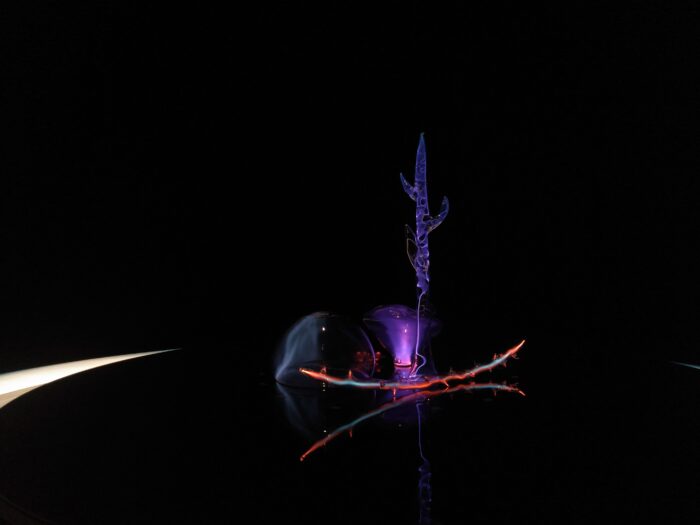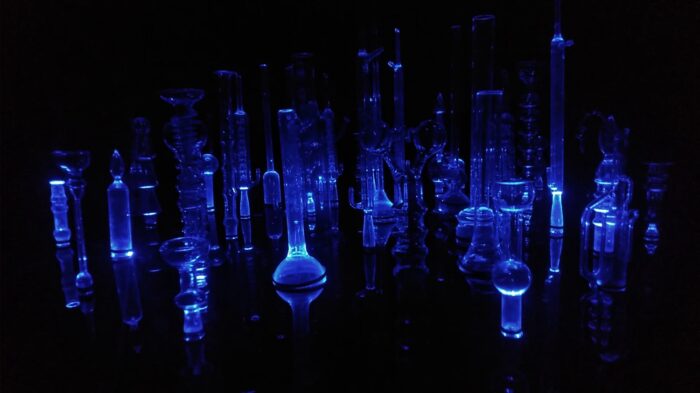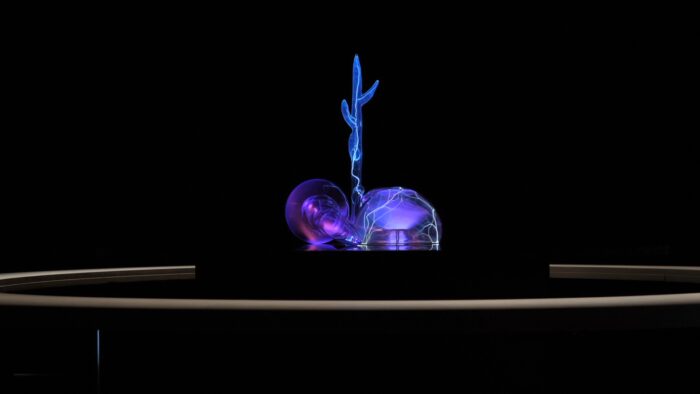Ectoplasm Feminism
Notes on the materiality of ghosts
What material are ghosts made of? We are used to imagining them as incorporeal beings, they float in mid-air, disappear at will, and pass through concrete walls. The ghost’s incorporeality, however, is not what makes it frightening. That is, instead, the only thing that makes its horror tolerable. The ghost’s transformation into a disembodied hologram is a defense mechanism. Its complete estrangement from the body spares us from the possibility of contamination, it protects us from the realization that our flesh, too, could be a festering nest of restless shadows. I would like to invite you to rethink the question of the materiality of the ghost, to imagine what it might mean for a ghost to have a body, and for a body to be ghostly. I ask you not to think of this question in terms of haunting or possession. There are no holy or demonic spirits here, invading the quiet container of the body. My proposal, instead, requires a more challenging and more disturbing leap of imagination, what if flesh itself were the ghost?
We think of our body as an assemblage of images: our reflection in the mirror, the selfies we post online, the arrangement of muscles and organs in our school textbooks, the X-ray we took when we broke our foot. Then there are the cells, molecules, and atoms that make us up, a matryoshka of increasingly abstract diagrams that penetrate the transparent substance of our flesh ever more deeply. The body is there, it is the thing represented, the obvious object to which all images point. Yet, if you think about it, your body is none of these images, and none of these images belong to you. Somewhere inside you, you already know that a body is not this. You may have felt it, briefly, in pain or ecstasy—the ghost that lurks beyond abstractions. I ask you to think of all these images as cultural containment systems that keep your flesh from dangerously oozing away. What is left of the body when the light goes out? What does a body do in the dark?

Parasites
The ectoplasm story begins in the near darkness of a Neapolitan séance room. It is 1894 and the medium Eusapia Palladino is communicating with spirits from otherworldly realms before a panel of distinguished scientists. Nobel prize-winning biologist and eugenicist Charles Richet is morbidly observing the gaping scar across Eusapia’s forehead when, in the half-light, he witnesses something slipping out of that monstrous slit: an amorphous, milky secretion, neither vapor nor liquid, radiating with a moon-like glow. Between Eusapia’s orgasmic moans, the substance dances before the spectators’ eyes as if endowed with a life of its own. None of those present can define the contours of its surface; as soon as it seems to congeal into an abortion of human form, the material melts away and returns to its original indistinction. After its first appearance, ectoplasm begins to spread like a disease. All the mediums across Europe begin to vomit it, to weep it, to give birth to it; they secrete impressive amounts of it from every crevice of their bodies. The scholars who witness the materialization of ectoplasm devote their lives to the interrogation of this elusive material, yet none of them can determine with confidence its exact nature.
To ask “what is” an ectoplasm, after all, is a contradiction in terms: ectoplasm does not respond to the grammar of “being.” An aberrant offspring of positivism, it is as much a product of the gaze of science as it is the harbinger of its failure. The word “ectoplasm” originated in nineteenth-century biology to refer to living material placed outside any predetermined form. It is the body without its image, flesh outside its structure, not an organism but a disorganism. By its very nature, ectoplasm has a privileged relationship with death, understood both as the end of life, and as the pre-organic condition that makes it possible: it is both a posthumous residue and an embryo of the future. Pre- and posthuman, ancestral and apocalyptic, never-born and undead, ectoplasm is a body that travels through time.
Whenever it is exposed to light, ectoplasm is immediately disintegrated. To exist, it must remain unseen. Ectoplasm cannot, therefore, be represented, but this does not prevent it from leaving traces. The photographic plates used during séances were contaminated with strange marks—burns, scratches, glares, not true images but vestiges of a contact. Ectoplasm’s ability to infiltrate the materiality of the space between the thing represented and the gaze that observes it allows it to escape any play of mirrors. It is reassuring to tell ourselves that ectoplasm is a narrative, a fantasy, or a cultural construction. Still, a body can resist representation without necessarily becoming abstract—it can reject any fixed identity precisely by virtue of its opacity.
“The defenses against the phantoms breed phantoms, and vice versa”, wrote Luce Irigaray in Speculum. The more desperately we search for the truth of the body, the darker its shadows grow. Where is ectoplasm hiding? In the eyes of the beholder or the darkness out there? Ectoplasm entertains a perverse relationship with the eyes that observe it, their gaze seems to mysteriously elicit its appearance, although it ultimately always escapes them. The development of photography, for instance, is inseparable from the history of spiritualism; it was the ambition to capture supernatural imprints which refined and perfected the earliest forms of photographic technology. By chasing each other within and beyond the shadows of the séance rooms, ghosts and media have pushed each other closer and closer to the limit of the imperceptible; they have co-evolved as reciprocal parasites, engaging in an arms race to become increasingly undetectable and ethereal. Michel Serres has defined the parasite as a process of epistemic interference: whenever we try to access, know or represent reality, something other than the object we were looking for always gets in the way. Parasites are glitches, noises, errors, interruptions that often remain unseen, but constantly disturb our relationship with the world. According to Serres, the interference of the parasite constitutes an ineradicable aspect of every process of communication and knowledge; any attempt to get rid of it will only result in its increased proliferation. “A new obscurity accumulates in unexpected locations, spots that had tended toward clarity,” he writes, “we want to dislodge it but can only do so at ever-increasing prices and at the price of a new obscurity, blacker yet, with a deeper, darker shadow.”
Ironically, ectoplasm first materialized at the precise moment when the gaze of science began to turn to women’s bodies as objects of its knowledge. How to forget the tortures endured by “hysterical” patients or the mutilations of enslaved black women at the hands of James Marion Sims, the “father of modern gynecology,” who first revealed their insides under the cold light of his speculum? But whether ectoplasm was an aberrant revelation or the hallucination of an eye that had looked too long into the body’s darkness does not make that much difference. Today, bodies are the object of endless gazes, ever more penetrating and ever more abstract; ectoplasm, a material that resists any image, is still their unavowable parasite. An unseen guest that continues to feed on their light.

A secret third thing
The search for another, parasitic space in the suffocating dialectic between objects and subjects, natures and cultures, matter and language is one of the most precious legacies of 20th-century materialist feminisms. A legacy that we have often forgotten or misunderstood, perhaps out of too much haste to abandon the darkness of the body and finally find ourselves on the “right” side: that of subject, culture, and language. Today, our chronic dissatisfaction with this decision echoes in the memes of girls online when, in search of an escape from all predetermined identities, they claim to be a ”secret third thing” refusing to elaborate any further. In a world dominated by identity and self-representation, there is a generalized longing to melt away into a state of ghostly formlessness.
It was Julia Kristeva who famously crystallized this spirit of rejection in her work Powers of Horror. The process of individuation of the subject, made possible only at the price of objectifying the other, is always in danger of being disrupted by the appearance of a secret third thing, other than the subject, but this time revolting and indocile. “Not me,” she writes, “not that. But not nothing, either. A something that I do not recognize as a thing.” Kristeva named this undomesticated third other the “abject”. Abjection is, in essence, our response towards something that is not part of ourselves, but not entirely separate from us, either. The abject cannot be rationalized as an object, but neither can it be assimilated within the boundaries of the subject. To exemplify this idea, Kristeva speaks of excrement, bodily fluids, and corpses; all these materials are connected to the human body, they originate from it and are necessary to its existence, yet they are expelled and rejected—both physically and culturally—as threats to its integrity. Like ectoplasm, the abject lingers on “the edge of nonexistence and hallucination”: it inhabits a boundary condition, but this boundary is so thin that it always threatens to be broken. The reason why the abject is the deepest crisis of the patriarchal subject is that it refuses to be the stable ground on which subjectivity can stand. It is too close to be ignored, yet too far to be captured. It is much more than a monster, it is not merely an exception to the natural order of things but suggests that that very order is infested with parasites, that it rises on haunted grounds.
The most prolific producer of ectoplasm in the history of spiritualism was Marthe Beraud, a French woman who achieved worldwide fame as a medium in the early 20th century under the alias of Eva Carrière, or Eva C. She was never alone: alongside her in the shadows of the séance room sat Juliette Bisson, a wealthy, much older woman who was her “ectoplasmic midwife” and lover. The materializations of Eva C. became well-known for being somewhat perverse and obscene, with ectoplasm hiding into and oozing out of all her orifices. “Yesterday I hypnotized Eva as usual, and she unexpectedly began to produce phenomena,” wrote Bisson in a letter. “As soon as they began, Eva allowed me to undress her completely. I then saw a thick thread emerge from the vagina. It changed its place, left the genitals, and disappeared in the navel depression. More material emerged from the vagina, and with a sinuous serpentine motion of its own it crept up the girl’s body, giving the impression as if it were about to rise in the air. Finally it ascended to her head, entered Eva’s mouth, and disappeared.” At times, the séances of Eva C. escalated into ghostly displays of sapphic sex between the medium, her lover, and ectoplasm itself.

In the 1970s, Monique Wittig described the lesbian body as an uninterrupted flow of mutating organs—a subversive material crossing the boundaries of human, animal, vegetal, and mineral. In lesbian passion, the lover’s body becomes bacterium, granite, swarm, and corpse; it explodes into thousands mutilated pieces and congeals into new, unprecedented forms. In Wittig’s work, the linguistic order of the organism is methodically dismantled: its anatomy is unfolded, torn, chewed, and digested. Despite its formlessness, this body is not virtual, but rather ectoplasmic: its materiality seeps through the fabric of a language that barely outlines it, always incapable of fully containing it. Wittig does not reject the body itself but demonstrates how embodiment is limited by its essentialist representations; she is not trying to escape the body, but the patriarchal structures of knowledge and power that have forced it into passivity and submission. The inhuman mutations of Wittig’s lesbian body are at times ecstatic, at times torturous and revolting—there is an element of pain and horror, of abjection, which, once embraced, often overflows into orgasmic joy. The human subject seems to struggle to keep up with the flesh it inhabits, which in turn accelerates uncontrollably until its humanity is completely fractured. Heterosexuality, then, is understood as a security system: a defense against ghosts, a cage that constrains the body out of fear of ectoplasmic disintegration.
Is The Lesbian Body truly a work of literary fiction? Are Wittig’s phantasmagoric descriptions of her and her lover’s ecstatic metamorphoses any less “real” than our prescriptive visions of the body as a disciplined organism? Ask yourself: what does a body feel like to you? To reopen the secret third space of the body, we must take courage—we must venture back into the abject persistence of the very matter we have been taught to dread as a prison.

Where does a body end?
Ectoplasm is liminal matter: it only exists in-between life and death, light and dark, spirit and flesh, self and other. During séances, ectoplasm manifested as a mysterious secretion whose existence was simultaneously connected to, and separate from, the body of the medium. The medium could experience the sensations of her ectoplasm as if it were part of her own body, yet she could not entirely control its form and movements. Although nobody ever identified its nature, all witnesses agreed that ectoplasm was somewhat soft and wet; fluidity, viscosity, and stickiness were its only identifiable physical attributes. The disquieting softness of ectoplasm is a fundamental aspect of ghostly materiality. To be soft is, in essence, to be enveloped by a mutable surface rather than to be enclosed within a solid volume. Softness implies the possibility of dissolution and contamination: while solid matter is stable and predictable, soft bodies can be wounded, stretched, folded, and mixed into each other. Luce Irigaray commented extensively on soft materiality in her writing, understanding that patriarchal subjectivity is both dependent on, and constantly threatened by, the permeable surfaces that surround it. “Fluid has to remain that secret remainder of the one”, she wrote in Speculum. “Blood, but also milk, sperm, lymph, saliva, spit, tears, humors, gas, waves, airs, fire… light. All threaten to deform, propagate, evaporate, consume him.”
The words “secret” and “secretion” share the same Latin root, the verb secernere—to separate, or tear away, something from oneself. But for living beings, secretions aren’t mere waste products: they are, rather, extensions of their body in the world. Spiders build lethal traps out of silk; scorpions inject deadly poison into their prey; snails grow tough protective shells; squids squirt ink to escape from predators; trees produce resin to disinfect their wounds. Secretions hunt, camouflage, nourish, signal, and heal—they are part of a wireless, interspecies communication infrastructure. For millions of years, secretions have connected bodies to each other: they are a technology that both precedes and overcomes the tyranny of language. Ectoplasm might be the cybernetics of the future.
A secretion is always productive, never reproductive—it is, at the same time, yourself and something entirely other. Its very existence is a testimony to the body not as a solid volume but as a generative, porous, ever-changing membrane. When was the last time you cried? Who are you when you bleed? What message is encoded in your sweat? Where does your body end? To be embodied is to follow the trail of this secret softness, beyond any attachment to our identity. Even if it challenges our subjective boundaries and draws us toward a place where meaning collapses.
Our body calls to us from the shadows, although we are still afraid to listen. We fear that this ghostly material will turn against us; ensnared in false dichotomies, we still conflate embodiment with the inflexibility of “nature”. We forget the teaching of the feminists that came before us—that to think of the abstract as a liberated space is to replicate an ancient metaphysics of matter as passive and unchanging. Ectoplasmic embodiment allows us to disavow the dogma of materiality as a solid substrate that restrains us. By making our body a ghost of living flesh, we recognize that we no longer need abstractions to release us from matter. Instead, we need a material released from the chains of all abstraction.



